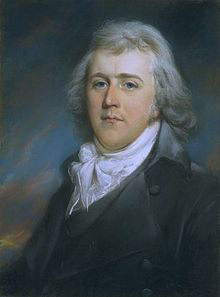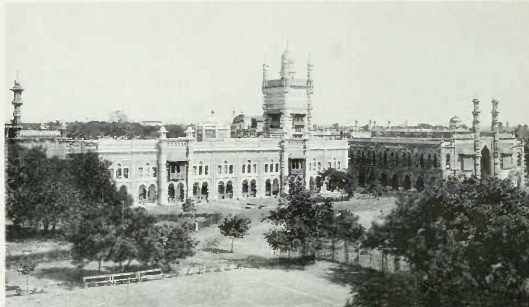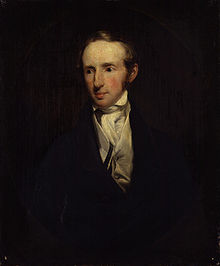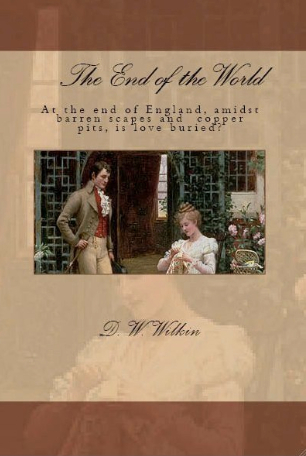D.W. Wilkin's Blog, page 12
November 28, 2016
RAP has The End of the World
The End of the World This is the first of the Regency Romances I published. It is available for sale and I hope that you will take the opportunity to order your copy.
For yourself or as a gift. It is now available in a variety of formats. And now at the reduced price of $3.99 you can get this Regency Romance for your eReader. A little more as an actual physical book.
Barnes and Noble for your Nook
Amazon for your Kindle and as a Trade Paperback
Hermione Merwyn leads a pleasant, quiet life with her father, in the farthest corner of England. All is as it should be, though change is sure to come. For she and her sister have reached the age of marriage, but that can be no great adventure when life at home has already been so bountiful.
When Samuel Lynchhammer arrives in Cornwall, having journeyed the width of the country, he is down to his last few quid and needs to find work for his keep. Spurned by the most successful mine owner in the county, Gavin Tadcaster, Samuel finds work for Gavin’s adversary, Sir Lawrence Merwyn.
Can working for Sir Lawrence, the father of two young women on the cusp of their first season to far away London, be what Samuel needs to help him resolve the reasons for his running away from his obligations in the east of the country?
Will the daughters be able to find happiness in the desolate landscapes and deadly mines of their home? When a stranger arrives in Cornwall while the war rages on the Peninsula, is he the answer to one’s prayers, or a nightmare wearing the disguise of a gentleman?
Feedback
If you have any commentary, thoughts, ideas about the book (especially if you buy it, read it and like it
November 27, 2016
Regency Personalities Series-James Stanier Clarke
Regency Personalities Series
In my attempts to provide us with the details of the Regency (I include those who were born before 1811 and who died after 1795), today I continue with one of the many period notables.
James Stanier Clarke
1766–4 October 1834

James Stanier Clarke
James Stanier Clarke was the eldest son of Edward Clarke and Anne Grenfield, and brother of Edward Daniel Clarke, he was born on 17 December 1766 at Mahon, Minorca where his father was at the time chaplain to the governor. He was educated at Uckfield School and then at Tonbridge School under Vicesimus Knox. Matriculating at St John’s College, Cambridge in 1784, he did not complete a first degree.
Having taken holy orders, Clarke was in 1790 appointed to the rectory of Preston, Sussex. About the beginning of 1791 he was living in Sussex with his mother, taking in the refugee Anthony Charles Cazenove for half a year. In 1792 he was living at Eartham with William Hayley; Thomas Alphonso Hayley made a bust of him.
Clarke in February 1795 entered the Royal Navy as a chaplain; and served, 1796-9, on board the HMS Impetueux in the Channel fleet, under the command of captain John Willett Payne, by whom he was introduced to George, Prince of Wales. It was the end of his service afloat, after George appointed him his domestic chaplain and librarian.
In 1806, Clarke took the degree of Bachelor of Laws (LLB) at Cambridge, and in 1816 the further degree of Legum Doctor (LLD) was conferred on him per literas regias. George had him made historiographer to the king on the death of Louis Dutens in 1812. He was also a Fellow of the Royal Society.
From 1815 for a short period Clarke was in contact with Jane Austen about her novel-writing: they were introduced by Austen’s friend the surgeon Charles Thomas Haden. Having shown Austen round the library at Carlton House in November, and arranged that George should have Emma dedicated to him, Clarke also made suggestions in correspondence for Austen’s future writing. These she mocked in the satirical manuscript Plan of a Novel, according to Hints from Various Quarters, not published in her lifetime.
Clarke was installed canon of Windsor, 19 May 1821; and was Deputy Clerk of the Closet to the king. The canonry came about by compromise between George IV (as George had become) and Robert Jenkinson, 2nd Earl of Liverpool the Prime Minister, in a clash over preferment for Charles Sumner. Under a deal struck, Sumner took on Clarke’s royal appointments.
Clarke died on 4 October 1834.
In 1798, Clarke published a volume of Sermons preached in the Western Squadron during its services off Brest, on board HM ship Impetueux (1798; 2nd edit. 1801). With John McArthur, a purser in the navy and secretary to Samuel Hood, 1st Viscount Hood at Toulon, he started the Naval Chronicle, a monthly magazine of naval history and biography, which ran for twenty years. In 1803 he published the first volume of The Progress of Maritime Discovery, which was not continued. He issued in 1805 Naufragia, or Historical Memoirs of Shipwrecks (3 vols.). Its subtitle “of the Providential Deliverance of Vessels” reflects its traditional content, harking back to James Janeway.
In 1809, with McArthur, Clarke published his major work, the Life of Lord Nelson (2 vols.; 2nd edit. 1840). It mixed official and private letters, and made questionable use of its sources. Robert Southey criticised it destructively in the Quarterly Review, a culmination of his literary feud with Clarke that led also to Southey writing his own Nelson biography.
In 1816, Clarke published a Life of King James II, from the Stuart MSS. in Carlton House (2 vols.). The work contains portions of the king’s autobiography, the original of which is now lost; in the Dictionary of National Biography it was considered to be the work of Lewis Innes, where Clarke attributed it to his brother Thomas Innes. A modern scholarly view is that the work was written in two parts by different Jacobite courtiers, the first part (to 1677) being by John Caryll, the second by William Dicconson. David Nairne assisted Caryll.
Clarke also edited William Falconer’s The Shipwreck, with life of the author and notes (1804), which ran to several editions, and Lord Clarendon’s Essays (1815, 2 vols.).


You Ought to Trust Your Mother (YOTTYM) now released
Now available the next Regency Romance tale by D.W. Wilkin:
Beauty has been said to be in the eye of the Beholder, or is it the Beholden.
The tale of Baron Fallion Lancelot Stafford, a gentleman of perhaps too much leisure who has served in the wars of some few years before. He now has decided that all this leisure is perhaps a waste and he should be doing something. He was just very unsure what that was.
We also find Lady Beatrice Cavendish, the daughter of the Earl of Hoare who is famed for her beauty, yet cannot find any man who has more to speak to her beyond that one subject. And yet far too many think they should offer for her with only the ardent praise to her looks to recommend them. Perhaps there exists one suitor who could speak on a subject beyond that?
In the rush of the Season of 1821, where their most intimate friends have all come to the conclusion that they should marry, can Beatrice put aside her willful ways and hear sound thoughts that her mama has said on that particular subject? Beatrice was sure that her mother would be content if she accepted the Baron Tweedglen, or any of a dozen other men of good breeding, position, or wealth. Whether they had ought to speak on her attractiveness, and no other words would leave their mouths.
Certainly a marriage with such foundations was doomed to crumble once age advanced and liver spots or wrinkles appeared. Yet amongst the Ton, such marriages were often deemed successes. Would they be so for Beatrice, though? That was something she was destined to apply her own thoughts to.
For Baron Tweedglen, the haunting memory of the war caused him to avoid any reference to his time spent prosecuting that undertaking. Such deamons as consumed his psyche, were magnified as his desire was for a world that art flourished and certainly his experience had been the exact opposite of such an inclination. The Baron was desperately in need of something that could save him from his own self. Was there a remedy in marriage as the entire Ton seemed to believe?
Now available on Amazon for $15.99…
also available for your Kindle and Kindle Reading Apps for $3.99
for those who have iPads, Nooks, or other devices, the book is also available at:
The Apple iBookstore, Barnes and Noble Nook store, Kobo, and Smashwords for $3.99 as well.


November 26, 2016
Regency Personalities Series-Paul Benfield
Regency Personalities Series
In my attempts to provide us with the details of the Regency (I include those who were born before 1811 and who died after 1795), today I continue with one of the many period notables.
Paul Benfield
1742–1810

Chepauk Palace built by Benfield
Paul Benfield was an English East India Company employee and trader, financier and politician. He is now known as a target for the rhetoric of Edmund Burke, and for his spectacular bankruptcy.
Benfield went out to India as a civil servant of the East India Company in 1764, on a modest salary. He reportedly amassed a fortune of over £500,000. At Madras he entered into partnership with local Indian bankers. He made money partly by trade, partly by loans at high rates of interest, and partly by contracts. He had extensive money transactions with the Nawáb of the Carnatic, and he entered into and completed contracts with the government for the construction of fortifications for the town of Madras and for Fort St. George.
One of Benfield’s major loans was made for the purpose of enabling the Nawáb, who, with the aid of the English, had recently invaded and conquered the Mahratta state of Tanjore, to satisfy some claims of the Dutch at Tranquebar on territories of the Rajah of Tanjore. Benfield was then charged with having helped malcontents in the Madras council, in conflict with George Pigot, 1st Baron Pigot. He was ordered by the Company’s court of directors in 1777 to return to England. He resigned the Company’s service, and on reaching London in 1779 demanded an investigation into his conduct.
Benfield made no attempt to conceal his loans to the Nawáb, stating that though they had been extensive, they had not been of a clandestine nature, and that they were well known to the governor, to the council, and indeed to the whole settlement. He alleged that he had enjoyed commercial confidence, argued that by his loans he had prevented war, and had promoted the interests of the Company. He was subsequently restored to the service and permitted to return to Madras: the court of directors resolving that his conduct, in relation to the loan to satisfy the claims of the Dutch, was beneficial.
During his stay in England in 1780, Benfield was elected to Parliament as member for Cricklade, spending freely to do so. At the same time William Burke was working for the Rajah of Tanjore. When Benfield brought an action for bribery against his opponent, S. Petrie, which was tried at Salisbury 12 March 1782, Petrie was defended by Richard Burke Jr. and William Pitt the Younger. Petrie was acquitted, and published an account of the trial with a letter giving his history of the case in 1782. It was said in the case that Benfield returned eight or nine members to parliament; this assertion is not now given credence.
Benfield finally returned to England, via France, in 1793. He established a mercantile firm in London, called Boyd, Benfield, & Co., with Walter Boyd. He entered Parliament again, for Malmesbury (1790), and then by buying into the seat of Shaftesbury. Boyd engaged in speculations which turned out badly, and Benfield’s fortune collapsed rapidly. He died in Paris in poverty in 1810.
In 1793 Benfield married Mary Frances Swinburne, of Hamsterley, Durham, eldest daughter of Henry Swinburne. The marriage settlement was lavish. They had a son and at least two daughters; their elder daughter Henrietta Sophia was married to Robert Berkeley, of Spetchley, while their younger daughter Caroline Martha was married in 1824 to Grantley Berkeley. Through these marriages, their descendants married into several aristocratic families such as the Feildings (earls of Denbigh & Desmond), and landed families.


Space Opera Books Presents Trolling, Trolling, Trolling Fly Hides
Trolling, Trolling, Trolling Fly Hides!
Not only do I write Regency and Romance, but I also have delved into Fantasy.
The Trolling series, (the first three are in print) is the story of a man, Humphrey. We meet him as he has left youth and become a man with a man’s responsibilities.
We follow him in a series of stories that encompass the stages of life. We see him when he starts his family, when he has older sons and the father son dynamic is tested.
We see him when his children begin to marry and have children, and at the end of his life when those he has loved, and those who were his friends proceed him over the threshold into death. All this while he serves a kingdom troubled by monsters.
Troubles that he and his friends will learn to deal with and rectify.
It is now available in a variety of formats. For $2.99 you can get this fantasy adventure.

Barnes and Noble for your Nook
Old age is catching up to Humphrey and his friends. He feels it in his bones and with his son and heir having reached the prime of his life, it could very well be time to pass the baton of rule to Daniel.With the Valley Kingdom of Torahn at Peace, that would not be a terrible thing to do. Though breaking his decision to his wife Gwendolyn, the Queen, might be the hardest battle that he ever would fight.
Even as the life of retirement looks to be attractive and possible, however, the Valley Kingdom is beset again. Not Goblins, Trolls, Giants or Men, this time. No. That Humphrey knew would be far too easy.
Those obstacles had been overcome before and the problems they presented had solutions that the army of Torahn was trained to deal with. No, of all the creatures that came forth from Teantellen that they had beaten, the one they had never faced now came forth. Dragons!
Who in the realm knew how to fight these mythical beasts? Was there even away to do so?
Now Humphrey who had thought to spend the remainder of his days quietly writing his memoirs and drinking, was faced with the greatest challenge he had ever known.
Feedback
If you have any commentary, thoughts, ideas about the book (especially if you buy it, read it and like it
November 25, 2016
Regency Personalities Series-Royal Academy of Music
Regency Personalities Series
In my attempts to provide us with the details of the Regency (I include those who were born before 1811 and who died after 1795), today I continue with one of the many period notables.
Royal Academy of Music
1822-
Royal Academy of Music was founded in 1822 and is Britain’s oldest degree-granting music school. It received a Royal Charter in 1830. It is a registered charity under English law.
The Academy was founded by Lord Burghersh in 1822 with the help and ideas of the French harpist and composer Nicolas Bochsa. The Academy was granted a Royal Charter by King George IV in 1830


An Unofficial Guide to how to win the Scenarios of Wild the 2nd Expansion for Rollercoaster Tycoon 3
An Unofficial Guide to how to win the Scenarios of Wild
I have been a fan of this series of computer games since early in its release of the very first game. That game was done by one programmer, Chris Sawyer, and it was the first I recall of an internet hit. Websites were put up in dedication to this game where people showed off their creations, based on real amusement parks. These sites were funded by individuals, an expense that was not necessarily as cheap then as it is now. Nor as easy to program then as it might be to build a web page now.
Prima Books released game guides for each iteration of the game, Rollercoaster Tycoon 1, Rollercoaster Tycoon 2 and Rollercoaster Tycoon 3 (RCT3) but not for the expansion sets. And unlike the first two works, the third guide was riddle with incorrect solutions. As I played the game that frustrated me. And I took to the forums that Atari, the game publisher hosted to see if I could find a way to solve those scenarios that the Prima Guide had written up in error. Not finding any good advice, I created my own for the scenarios that the “Official” Guide had gotten wrong.
Solutions that if you followed my advice you would win the scenario and move on. But if you followed the “Official” version you would fail and not be able to complete the game. My style and format being different than the folks at Prima, I continued for all the Scenarios that they had gotten right as well, though my solutions cut to the chase and got you to the winner’s circle more quickly, more directly.
My contributions to the “Official” Forum, got me a place as a playtester for both expansions to the game, Soaked and Wild. And for each of these games, I wrote the guides during the play testing phase so all the play testers could solve the scenarios, and then once again after the official release to make changes in the formula in case our aiding to perfect the game had changed matters. For this, Atari and Frontier (the actual programmers of the game) placed me within the game itself.
And for the longest time, these have been free at the “Official” Forums, as well as my own website dedicated to the game. But a short time ago, I noticed that Atari, after one of its bankruptcies had deleted their forums. So now I am releasing the Guide for one and all. I have added new material and it is near 100 pages, just for the first of the three games. It is available for the Kindle at present for $2.99.
(Click on the picture to purchase)
Not only are all 12 Scenarios covered, but there are sections covering every Cheat Code, Custom Scenery, the famous Small Park Competition, the Advanced Fireworks Editor, the Flying Camera Route Editor which are all the techniques every amusement park designer needs to make a fantastic park in Rollercoaster Tycoon 3.
Scenarios for WILD!
1) Scrub Gardens
2) Ostrich Farms Plains
3) Egyptian Sand Dance
4) A Rollercoaster Odyssey
5) Zoo Rescue
6) Mine Mountain
7) Insect World
8) Rocky Coasters
9) Lost Land of the Dinosaurs
10) Tiger Forest
11) Raiders of the Lost Coaster
12) Saxon Farms


November 24, 2016
Regency Personalities Series-Charles Churchill (of Chalfont)
Regency Personalities Series
In my attempts to provide us with the details of the Regency (I include those who were born before 1811 and who died after 1795), today I continue with one of the many period notables.
Charles Churchill (of Chalfont)
1720–1812
Charles Churchill (of Chalfont) was the only son of Lieutenant-General Charles Churchill by the actress Anne Oldfield. His grandfather, also Charles Churchill, was a British army officer and brother of the 1st Duke of Marlborough.
At the 1741 general election he was returned to the House of Commons as a Member of Parliament (MP) for the borough of Stockbridge in Hampshire, and held the seat until the next election, in 1747. At the 1747 election he was returned as an MP for Milborne Port, but it was a double return and Churchill was not one of those seated. At the 1754 general election he was elected as an MP for Great Marlow in Buckinghamshire, and held that seat until the next election, in 1761.
He married Lady Maria Walpole, daughter of Robert Walpole. Their daughter Mary became the second wife of Charles Cadogan, 1st Earl Cadogan, and had issue.


Fantasy from Space Opera Books, Trolling’s Pass and Present
Trolling’s Pass and Present
Not only do I write Regency and Romance, but I also have delved into Fantasy. The Trolling series, (the first three are in print) is the story of a man, Humphrey.
We meet him as he has left youth and become a man with a man’s responsibilities. We follow him in a series of stories that encompass the stages of life.
We see him when he starts his family, when he has older sons and the father son dynamic is tested. We see him when his children begin to marry and have children, and at the end of his life when those he has loved, and those who were his friends proceed him over the threshold into death.
All this while he serves a kingdom troubled by monsters. Troubles that he and his friends will learn to deal with and rectify.
It is now available in a variety of formats. For $2.99 you can get this fantasy adventure.
Barnes and Noble for your Nook
Years since their battles with the Trolls, even on foreign soil, the warriors of the Valley Kingdom of Torahn need something to keep their edge honed.
The economy too is beginning to fray a little without the great wars to support. The Leaders hit upon the idea of searching for a path to reach the east side of the continent.
The Elves swear that at one time their writings tell of such, the Dwarves swear such a pass across Teantellen is legendary. Teantellen though is filled with races man has never gotten along with well. Goblins, Dark Elves, Trolls, Giants and Dragons.
It has been years since the mountain tops exploded, and perhaps that has changed things enough that a way can be found to link the western lands with the eastern lands and increase trade, and prosperity for all. Even should they fail in their quest, as the history of man has shown to this point in time, the attempt will do much to spur the economy.
Tens of thousands of gold will be spent by the Council of Twenty-One to pay for such an expedition. Gold that those who are not so scrupulous might choose to pocket as they tried in the Troll Wars.
With such shenanigans taking place again, are the hopes of the previous generation, the leaders from the Troll Wars now in retirement, ready to be achieved? Is it time for Torahn, called the Valley Kingdom, but the only Kingdom without a King, to have a King once more?
Feedback
If you have any commentary, thoughts, ideas about the book (especially if you buy it, read it and like it
November 23, 2016
Regency Personalities Series-Samuel Prout
Regency Personalities Series
In my attempts to provide us with the details of the Regency (I include those who were born before 1811 and who died after 1795), today I continue with one of the many period notables.
Samuel Prout
17 September 1783 – 10 February 1852

Samuel Prout
Samuel Prout was born at Plymouth, the fourth of fourteen children born to Samuel Prout Senior, a naval outfitter in the dockyard city, and Mary Cater. Attending Plymouth Grammar School he came under the influence of Headmaster Dr. John Bidlake who encouraged the young Prout and Benjamin Robert Haydon in their artistic apprenticeship. They spent whole summer days drawing the quiet cottages, rustic bridges and romantic watermills of the beautiful valleys of Devon. With John Britton, he made a journey through Cornwall to try his hand in furnishing sketches for Britton’s Beauties of England. In 1803 he moved to London, where he stayed until 1812. Marrying Elizabeth Gillespie in 1810, they had four children; Rebecca Elizabeth (b. 1813), Elizabeth Delsey (b. 1817), Isabella Anne (b. 1820), and Samuel Gllespie (b. 1822).
In London, Prout saw new possibilities, and endeavoured to correct and improve his style by studying the works of the rising school of landscape. To earn a living, he painted marine pieces for Palser the printseller, took students, and published drawing books for learners. He was one of the first to use lithography.
It was not however until about 1818 that Prout discovered his niche. Happening time to make his first visit to the Continent, and to study the quaint streets and market-places of continental cities, he suddenly found himself in a new and enchanting province of art. His eye caught the picturesque features of the architecture, and his hand recorded them with skill. The composition of his drawings was exquisitely natural; their colour exhibited “the truest and happiest association in sun and shade”; the picturesque remnants of ancient architecture were rendered with the happiest breadth and largeness, with the heartiest perception and enjoyment of their time-worn ruggedness; and the solemnity of great cathedrals was brought out with striking effect.
He established his reputation with these street scenes, and gained praise from his erstwhile student John Ruskin. Until Prout, says Ruskin, excessive and clumsy artificiality characterized the picturesque: what ruins early artists drew “looked as if broken down on purpose; what weeds they put on seemed put on for ornament”. To Prout, therefore, goes credit for the creation of the essential characteristics lacking in earlier art, in particular “that feeling which results from the influence, among the noble lines of architecture, of the rent and the rust, the fissure, the lichen, and the weed, and from the writings upon the pages of ancient walls of the confused hieroglyphics of human history”. Prout, in other words, does not unfeelingly depict signs of age and decay chiefly for the sake of interesting textures, but rather employs these textures and other characteristics of the picturesque to create deeply felt impressions of age nobly endured. Whilst often compared, neither Turner nor Prout were vulgar artists, and while Turner concentrated upon the infinite beauties of nature, Prout, more interested by the cityscape.
Prout was appointed the coveted title of ‘Painter in Water-Colours in Ordinary’ to King George IV in 1829, and afterwards to Queen Victoria.
At the time of his death there was hardly a place in France, Germany, Italy (especially Venice) or the Netherlands where his face had not been seen searching for antique gables and sculptured pieces of stone. He died after a stroke at his home, 5 De Crespigny Terrace, Denmark Hill, London and was buried at West Norwood Cemetery.
A large quantity of his original sketchbooks, lithographs, account books, letters and family materials are held at the North Devon Athenaeum, Barnstaple, Devon. The collection was sold at auction in 2010, and much was acquired by Plymouth City Museum & Art Gallery, adding to its existing holdings of his work.
Samuel Gillespie Prout followed in his father’s footsteps by also painting watercolours. Another member of the family, John Skinner Prout made a career for himself painting and writing books in Tasmania.
Writing:
Picturesque Delineations in the Counties of Devon and Cornwall T. Palser, London 1812.
Prout’s Village Scenery T. Palser, London 1813.
Rudiments of Landscape in Progressive Studies (R. Ackermann London, 1813)
Picturesque Studies of Cottages R. Ackermann 1816
Sketches of the Thames Estuary T Palser London 1817
Marine Sketches Rowney & Forster, London 1820.
Picturesque Buildings in Normandy Rodwell and Martin, London 1821.
Views in the North of England R. Ackermann 1821.
Studies from Nature Rodwell & Martin London 1823
Illustrations of the Rhine J. Dickinson 1824.
Views in Germany J. Dickinson 1826.
Interior and Exteriors Ackermann & Co 1834
Hints on Light and ShadowAckermann & Co 1838
Prout’s Microcosm Tilt & Bogue, London 1841.










